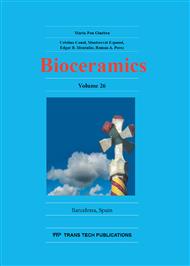p.184
p.193
p.198
p.202
p.207
p.212
p.216
p.225
p.231
Sintering Behavior of Nanostructured Hydroxyapatite Ceramics
Abstract:
The synthesis of nanoparticles appropriate for the preparation of nanostructured hydroxyapatite ceramics intended for bone repairs and regeneration is an interesting field of biomaterials research today. In this work nanoparticles of hydroxyapatite were obtained by the precipitation method using conventional magnetic stirring (A) and ultra turrex homogenizer (T1) accompanied with surfactant (T2) and dispersant agents (T3). In all cases, powders with nanometric dimensions were obtained and the unique calcium phosphate phase detected was hydroxyapatite (HAp). The powders sintering behaviour was studied. The ceramics obtained from powders prepared by magnetic stirring (A) showed the best values of final density (96.7 %) which it was in agreement with the lowest temperature of the beginning of shrinking (648.6 °C) during sintering determined by dilatometry. Nanostructured nature of these ceramics was confirmed by Scanning Electron Microscopy (SEM).
Info:
Periodical:
Pages:
207-211
Citation:
Online since:
November 2014
Price:
Сopyright:
© 2015 Trans Tech Publications Ltd. All Rights Reserved
Share:
Citation:


